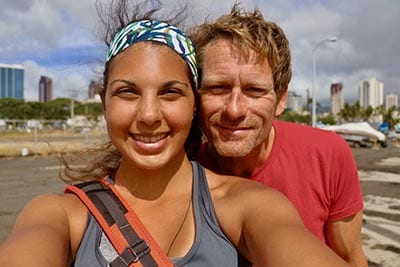Erica Cirino (BA, 2015)

From Environmental Journalist Erica Cirino ’15 Finds Solace in Nature on Stony Brook News by Glenn Jochum on April 17, 2017
Writer, artist, runner and licensed wildlife rehabilitator — this is how Erica Cirino ’15 identities herself. Perhaps survivor should be added to the description.
Her childhood memories are dominated by discord. Voices escalate in anger and accusations; a door slams, followed by the sound of a woman sobbing. A car starts up in the driveway; a man is bound for who knows where. When the little girl wakes up in the middle of the night, she sees her father on the couch. Again.
The days that follow bring more of the same — ongoing family drama that no child could be capable of stopping or escaping.
This is how Erica remembers parts of her childhood — a painful chapter that will stay with her always but was instrumental in making her the strong woman and successful wildlife journalist that she is today.
While her parents didn’t get along with each other, they did each stand by her side as she grew up. While at times her life wasn’t easy, Erica is grateful for her parents, who offered her their support and resources, cheering her on at track meets, buying her art supplies and encouraging her to pursue her natural talents.
But Erica also dug deep into her personal well and at a very young age found a way to cope with domestic upheaval. She chanced upon an inviting world, just walking distance from where she lived. This haven, Caumsett State Historic Park Preserve in Lloyd Neck, New York, was inhabited by chattering squirrels and nervous rabbits, scolding blue jays and drumming woodpeckers. With a notebook and sketch pad in hand, Erica recorded the wonders of the natural world.
Caumsett was where she could retreat into an alternative reality. As Erica got older, she found the preserve offered her a new kind of escape — running. At first she pursued it to put distance between herself and her pain. Eventually it became a need that she satisfied by becoming a competitive runner in high school.
Cold Spring Harbor High School required seniors to perform 20 hours of community service. Serendipitously, Caumsett had a wildlife hospital, so Erica volunteered there. She found the experience both uplifting and transformative: In the process of rehabilitating sick and injured wildlife, Erica learned how to heal her own emotional wounds.
She worked with opossums, turtles and other small mammals, but especially enjoyed caring for injured hawks and owls. Learning about the creatures’ life histories was soothing, she says, and she came to view them as new family members who depended upon her for their survival and would never abandon her.
Although Erica found the work rewarding, it was not without its challenges.
“It was a dirty job, one in which I was on my feet all day, got kicked and scratched, and was exposed to the elements,” she says. “But it taught me how to deal with loss and death, and perhaps it braced me for the loss of my father from my life,” she says.
Erica says working with wildlife filled a hole in her soul, and she became a licensed wildlife rehabilitator at age 16.
By this time, running had also taken on a greater significance in her life, becoming far more than a coping mechanism. As Erica’s reputation as an athlete grew, 30 colleges lined up to offer her track and cross-country scholarships. She pondered her options, but in the end her love for healing wounded animals won out.
Erica decided to live at home, continue to rehabilitate animals and apply to Stony Brook Southampton, where she could study marine vertebrate biology and further her career in wildlife sciences. Erica was accepted but shortly thereafter, as a result of New York State budget cuts, Stony Brook Southampton relocated its undergraduate programs and students to its main campus where she received her BA in Environmental Studies.
The change in venue did not deter Erica, who immersed herself in her studies. She had loved science and writing and now she looked to combine her thirst for scientific knowledge with her creative nature and become a science writer.
East Setauket, NY; Safina Center: Carl Safina talks with Stony Brook University alumni and freelance science writer and artist Erica Cirino.
It was in Professor Heidi Hutner’s Environmental Writing and Media class in 2012 that Erica met the person who would most influence her academic and professional career, Carl Safina. Safina, a renowned conservationist, author and founding president of the non-profit organization, The Safina Center, was guest lecturing about the human connection to nature.
“He asked the class a question about conservation and I answered it, and although I don’t recall my question I do remember Carl challenging me to delve deeper,” she says. “I was a confident college sophomore at the time and I was a little annoyed because I thought I had been so eloquent. But I went home that day and realized he was really helping me.”
Little did Erica know at the time that this encounter was the beginning of arguably her strongest and most formative professional relationship —one that would allow her to flex her literary muscles and truly discover both the scientist and the writer within.
Erica thrived at Stony Brook and enjoyed a college career that most students would envy, going on to make dean’s list every semester and winning seven awards. In 2014 alone, she landed three awards — the Sustainability Studies Program Director’s Award for Academic Excellence, the School of Marine and Atmospheric Sciences’ Undergraduate Honors Award, and was named the Stony Brook University Undergraduate College of Leadership and Service Creative Expressions Contest Winner.
When Erica was in her senior year, she and her mother were researching graduate schools and discovered the perfect solution to cement her career as a science writer — Stony Brook’s Master of Science Program in journalism — a curriculum that she found appealing because of its fast pace and the fact that she was “never good at sitting still.”
Another plus, she says, is that the program required that she would only have to spend a year and a half in the classroom. After some consideration, Erica decided she wanted to become a freelance science writer.
Erica felt confident she could embark on this new course of study, as her competitive running background imbued in her strong time-management skills, self-motivation and drive.
“I can do this,” she remembers thinking.
Through her studies, she honed her photography skills but sought to become a better writer. Her final master’s project, which required her to find and cover a big story, gave her that opportunity.
For her project, Erica highlighted the 2014-2015 avian influenza epidemic. She traveled to Wisconsin, one of the Midwestern states where the poultry industry was adversely affected.
As her full-time freelance writing career took off in 2016, Erica began writing for a greater number of publications, including National Geographic’s Voices blog. She focused heavily on ocean issues, in February 2016 and wrote a piece titled, “More Plastic, Fewer Oysters?” This led to a whole National Geographic blog series on ocean plastics. The blogs included interviews with some of the foremost experts on plastic pollution.
In October 2016, professional artist and photographer Chris Jordan, famous for his shocking photographs of dead albatross filled with ocean plastic, mentioned Erica’s work to a Danish organization working to quell plastic pollution. Jordan was invited on a trip across the Eastern Pacific Ocean and the organization, called Plastic Change, was looking for an American journalist.
Jordan, who knew of Erica through the Safina Center — where he was a Fellow and Erica was a freelance writer — recommended the group bring her on the voyage. Last spring Erica attended one of Jordan’s art shows in New York City and introduced herself. The two talked for hours about art and potential future collaborations.
In November, Erica and Jordan embarked on the 54-foot S/Y Christianshavn with members of Plastic Change in an effort to generate publicity about the group’s fact-finding expedition.
The vessel used trawling nets to determine the quantity, type and current state of plastic pollution on the Pacific Ocean Gyre, a swirling ocean current sometimes referred to as the Great Pacific Garbage Patch.
Aboard the ship, Erica focused on still photography and writing, and Jordan concentrated on filming plastic and the crew at work. Climbing into a patched-up old inflatable dinghy that was launched from the main vessel, Erica and Jordan were set adrift for a half-hour or so. They were entrusted with a waterproof camera bag containing thousands of dollars’ worth of equipment and dealt with setbacks — such as a slow leak that sprayed water everywhere, drenching them.
Erica did more than sharpen her journalism skills on the ocean voyage, however.
“The crew fully incorporated me into sailing tasks, which I really appreciated,” she says. “It was incredible learning how to sail and to do it correctly. I owe most of what I learned to the sailing partner assigned to me — Rasmus Hytting.”
Hytting, or “Ras” as Erica now refers to him, is a Danish carpenter and boat builder with more than three decades of sailing experience. While Hytting was considered to be a stern taskmaster and judge of his crewmembers’ sailing techniques, Erica’s quickness to learn garnered his respect, laying the foundation for a friendship they shared during the six weeks they spent together.
The sea can be a harsh environment for someone embarking on an extended maiden ocean voyage. “I truly felt comfortable on the ship despite the fact it was small and heaved around by huge waves. Spending any time in the cockpit usually meant you would get drenched by either waves or rain,” Erica says. “Admittedly, life on board wasn’t easy — for instance, our toilet was a bucket and we could only wash sparingly with fresh water — but I enjoyed the simplicity and challenges of being a sailor enormously because it made me appreciate what we did have on the ship —camaraderie and friendship.”
Erica adds that even when the ship experienced an engine malfunction and a snapped rudder en route to Hawaii, she never felt that she was in danger because she trusted the crew completely.
Even before this ocean assignment, Erica’s writing has appeared in prestigious publications such as The Atlantic and Scientific American. A sampling of her stories in those publications follows.
- More Plastic, Fewer Oysters? (National Geographic)
- The ‘Curious’ Robots Searching for the Ocean’s Secrets (Atlantic)
- Sea Unworthy: A Personal Journey into the Pacific Garbage Patch (Scientific American)
Her work has not gone unnoticed. None other than environmentalist humanitarian movie star Leonardo DeCaprio shared her Scientific American plastics story on his Facebook page; that led to a huge spike in readers and visitors to her own web site. Erica is eagerly bringing her message to the community, which has led to a speaking tour.
Although Erica is largely responsible for who she has become, she recognizes that every aspiring trailblazer needs assistance from an established professional, and Erica is grateful for the connections and opportunities Safina gave her.
“Most of us remember someone who took us under their wing, believed in us, let us think we could succeed,” says Safina. “We may have told them how much they meant to us. But the only way to show it is to be like them to someone.”
Mentorships are relationships after all, and the mentee must also recognize their value.
“I recommend that every young person find a mentor,” says Erica. “Carl is a great mentor to me not only because he is knowledgeable about the field I work in, but because he is a patient teacher who cares about my success. Find someone who is willing to both support and challenge you and you will be amazed by how much you grow personally and professionally.”
Erica’s life voyage could have derailed her dreams but her persistent optimism kept them afloat. “Life is full of suffering but if we work at righting our wrongs, I know it can also be full of beauty, love and happiness,” she says. “I’ve seen and experienced the worst and the best in life, and that’s helped me overcome new challenges that come my way.”
–Glenn Jochum



